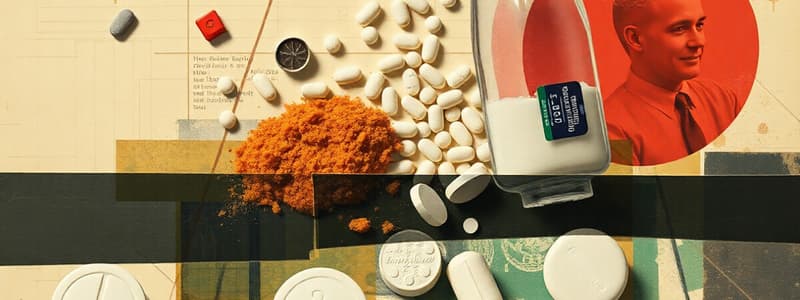Podcast
Questions and Answers
Which of the following describes the primary role of adsorbents in pharmaceutical formulations?
Which of the following describes the primary role of adsorbents in pharmaceutical formulations?
- Keeping powders dry by adsorbing moisture. (correct)
- Preventing foam formation in liquid preparations.
- Maintaining a stable pH in the preparation.
- Preventing oxidation of active pharmaceutical ingredients.
What is the main function of anti-foaming agents in liquid pharmaceutical formulations?
What is the main function of anti-foaming agents in liquid pharmaceutical formulations?
- To improve the solubility of the drug.
- To increase the viscosity of the liquid.
- To prevent the formation of foam. (correct)
- To protect active ingredients from oxidation.
Why are antioxidants included in some pharmaceutical formulations?
Why are antioxidants included in some pharmaceutical formulations?
- To maintain a stable pH.
- To improve the taste of the medication.
- To prevent microbial growth.
- To prevent oxidation of active pharmaceutical ingredients. (correct)
What is the purpose of anti-adherents and lubricants in tablet manufacturing?
What is the purpose of anti-adherents and lubricants in tablet manufacturing?
A pharmaceutical scientist is formulating a new oral solution and needs to ensure the pH remains constant. Which type of excipient is most suitable for this purpose?
A pharmaceutical scientist is formulating a new oral solution and needs to ensure the pH remains constant. Which type of excipient is most suitable for this purpose?
Which of the following describes the primary function of chelating agents in pharmaceutical formulations?
Which of the following describes the primary function of chelating agents in pharmaceutical formulations?
What is the main reason for using coatings on tablets?
What is the main reason for using coatings on tablets?
Why are diluents or fillers used in the manufacturing of tablets and capsules?
Why are diluents or fillers used in the manufacturing of tablets and capsules?
What is the role of disintegrants in solid dosage forms like tablets and capsules?
What is the role of disintegrants in solid dosage forms like tablets and capsules?
A pharmacist is compounding a topical ointment and needs an excipient to soften and soothe the skin. Which type of excipient is most appropriate?
A pharmacist is compounding a topical ointment and needs an excipient to soften and soothe the skin. Which type of excipient is most appropriate?
What is the primary purpose of enteric coatings on tablets?
What is the primary purpose of enteric coatings on tablets?
A formulation scientist is trying to increase the viscosity and provide physical stability to a suspension. What type of excipient should they consider using?
A formulation scientist is trying to increase the viscosity and provide physical stability to a suspension. What type of excipient should they consider using?
Which property of powders is improved by glidants?
Which property of powders is improved by glidants?
What is the primary purpose of humectants in pharmaceutical creams and ointments?
What is the primary purpose of humectants in pharmaceutical creams and ointments?
A pharmacist needs to dissolve a water-soluble solute in a formulation. Which type of solvent is most appropriate?
A pharmacist needs to dissolve a water-soluble solute in a formulation. Which type of solvent is most appropriate?
Which type of solvent is best suited for dissolving lipophilic substances?
Which type of solvent is best suited for dissolving lipophilic substances?
What is the primary function of levigating or wetting agents in pharmaceutical compounding?
What is the primary function of levigating or wetting agents in pharmaceutical compounding?
Why are opaquing agents included in some pharmaceutical formulations?
Why are opaquing agents included in some pharmaceutical formulations?
What is the purpose of preservatives in pharmaceutical formulations?
What is the purpose of preservatives in pharmaceutical formulations?
Which best describes the use for suppository bases?
Which best describes the use for suppository bases?
Flashcards
What are Adsorbents?
What are Adsorbents?
Substances used to keep powders dry by adsorbing moisture.
What are Anti-Foaming Agents?
What are Anti-Foaming Agents?
A compound that breaks and prevents foam formation in liquid preparations.
What are Antioxidants?
What are Antioxidants?
Substances that prevent the oxidation of active pharmaceutical ingredients (APIs), improving product stability.
What are Anti-Adherents / Lubricants?
What are Anti-Adherents / Lubricants?
Signup and view all the flashcards
What are Buffering Agents?
What are Buffering Agents?
Signup and view all the flashcards
What are Chelating Agents?
What are Chelating Agents?
Signup and view all the flashcards
What are Coatings (in drug formulations)?
What are Coatings (in drug formulations)?
Signup and view all the flashcards
What are Diluents / Fillers?
What are Diluents / Fillers?
Signup and view all the flashcards
What are Disintegrants?
What are Disintegrants?
Signup and view all the flashcards
What are Emollients?
What are Emollients?
Signup and view all the flashcards
What are Enteric Coating Agents?
What are Enteric Coating Agents?
Signup and view all the flashcards
What are Gelling / Thickening Agents / Stabilizers?
What are Gelling / Thickening Agents / Stabilizers?
Signup and view all the flashcards
What are Glidants?
What are Glidants?
Signup and view all the flashcards
What are Humectants?
What are Humectants?
Signup and view all the flashcards
What are Hydrophilic Solvents?
What are Hydrophilic Solvents?
Signup and view all the flashcards
What are Hydrophobic Solvents?
What are Hydrophobic Solvents?
Signup and view all the flashcards
What are Levigating / Wetting Agents?
What are Levigating / Wetting Agents?
Signup and view all the flashcards
What are Opaquing Agents?
What are Opaquing Agents?
Signup and view all the flashcards
What are Preservatives?
What are Preservatives?
Signup and view all the flashcards
What are Suppository Bases?
What are Suppository Bases?
Signup and view all the flashcards
Study Notes
- Study guide covering excipients in drug formulations
Adsorbents
- Examples: Magnesium oxide, magnesium carbonate, and kaolin.
- Purpose: Used to keep powders dry by adsorbing moisture.
Anti-Foaming Agents
- Example: Simethicone.
- Purpose: Breaks and prevents foam formation in liquid preparations.
Antioxidants
- Examples: Ascorbic acid, sodium bisulfite, and EDTA.
- Purpose: Prevents oxidation of active pharmaceutical ingredients (APIs), improving product stability.
Anti-Adherents/Lubricants
- Example: Magnesium stearate.
- Purpose: Prevents particles from sticking to each other or equipment, reduces friction, and improves powder flowability.
Buffering Agents
- Example: Sorensen's modified phosphate buffer.
- Purpose: Maintains a stable pH in the preparation.
Chelating Agents
- Example: EDTA.
- Purpose: Binds metal ions to prevent catalysis of oxidation reactions.
Coatings
- Examples: Shellac, gelatin, and gluten.
- Purpose: Protects from light, oxygen, and moisture, and masks unpleasant taste.
Diluents/Fillers
- Examples: Starches, calcium salts, lactose, cellulose, mannitol, and sorbitol.
- Purpose: Used to increase volume or size of tablets or capsules for easier handling.
Disintegrants
- Examples: Alginic acid, polacrillin potassium (Amberlite), cellulose products, starches, and compressed sugar.
- Purpose: Helps break up tablets/capsules in the body by absorbing water and swelling.
Emollients
- Example: Petroleum jelly.
- Purpose: Soothes and softens skin; can act as a topical drug vehicle.
Enteric Coating Agents
- Examples: Cellulose acetate phthalate and shellac.
- Purpose: Protects drugs from being destroyed by stomach acid by delaying release until the intestine.
Gelling/Thickening Agents/Stabilizers
- Examples: Gelatin, bentonite, agar, alginates, guar gum, acacia, tragacanth, carbomer, cellulose, starches, and pluronic gels.
- Purpose: Increase viscosity and provide physical stability to suspensions or gels.
Glidants
- Examples: Colloidal silica and magnesium stearate.
- Purpose: Improves flow properties of powders by reducing interparticle friction.
Humectants
- Examples: Glycerin and propylene glycol.
- Purpose: Prevents drying and brittleness in formulations.
Hydrophilic Solvents
- Examples: Polyethylene glycol (PEG) and alcohols.
- Purpose: Used to dissolve solutes that are water-soluble.
Hydrophobic Solvents
- Examples: Canola oil, coconut oil, and Omega-3 and Omega-6 fatty acids.
- Purpose: Used to dissolve lipophilic substances (not miscible with water).
Levigating/Wetting Agents
- Examples: Mineral oil, glycerin, polysorbate 80 (Tween 80), and propylene glycol.
- Purpose: Reduces particle size and improves dispersion into a medium.
Opaquing Agents
- Example: Titanium dioxide.
- Purpose: Provides light protection and improves product appearance.
Preservatives
- Examples: Chlorhexidine, sodium benzoate, benzoic acid, benzalkonium chloride, thimerosal, EDTA, and benzyl alcohol.
- Purpose: Prevents microbial growth in formulations.
Suppository Bases
- Examples: Cocoa butter (Theobroma oil), hydrogenated vegetable oils (e.g., palm, coconut oil), glycerinated gelatin, and polyethylene glycol (PEG) polymers.
- Purpose: Used as the carrier material for suppositories.
Surfactants
- Examples: Sodium lauryl sulfate, polysorbates (Tweens), and sorbitan esters (Spans).
- Purpose: Reduces surface tension, improves wetting and mixing, and neutralizes static charge.
Sweeteners
- Examples: Aspartame, saccharin, glycerin, dextrose, lactose, mannitol, sorbitol, phenylalanine, stevia, and xylitol.
- Purpose: Adds sweetness to oral or chewable preparations.
Water Types
- From most to least pure: Sterile water for injection (SWFI), purified water, potable water (tap or drinking water).
- Purpose: Universal solvent in formulations.
Excipients to Avoid in Certain Patient Populations
- Gelatin should be avoided in those avoiding pork; Hypromellose (cellulose-based capsule) can be used as an alternative.
- Gluten should be avoided in those with celiac disease or are gluten-sensitive; Corn starch or potato starch can be used as an alternative.
Studying That Suits You
Use AI to generate personalized quizzes and flashcards to suit your learning preferences.




